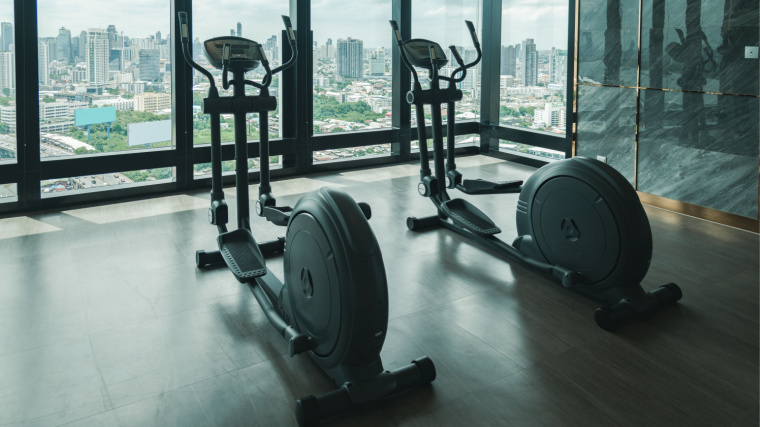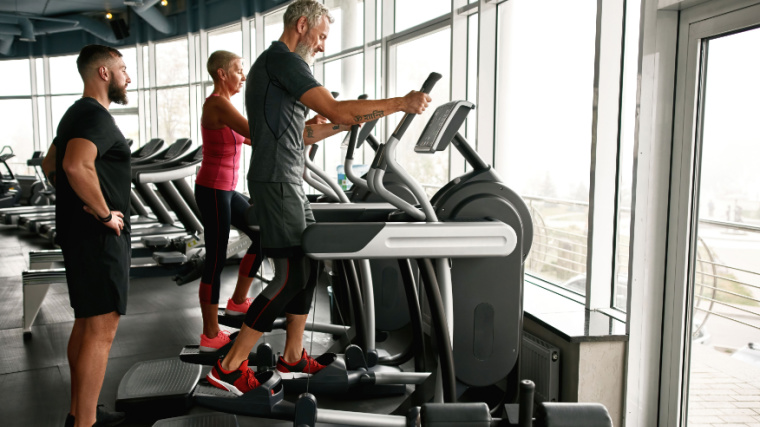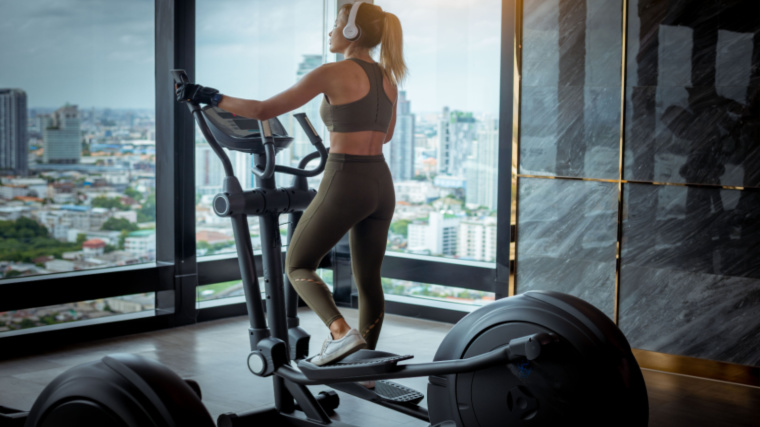When it comes to improving your cardiovascular health, you need to pick the right tool for the job. And that’s the rub — there are a lot of tools to pick from.
If you frequent your local gym, you’ve probably been paralyzed by choice at least once in the cardio section. There are dozens of treadmills, more than a handful of exercise bikes, two or three (or five) stair climbers, some sort of ladder contraption (do you climb it?) and, of course, a whole row of ellipticals.

Each piece of equipment is different, but they all serve the same general purpose of helping you strengthen your heart, improve your posture, and bolster your health. But you might be missing out if the elliptical isn’t your go-to. Here are 6 benefits of ellipticals and elliptical-based workouts that you need to know about before your next sweat session.
What Is an Elliptical?
Think of an elliptical as a cross between a treadmill and a stationary cycling bike. Ellipticals are designed to roughly mimic the human gait cycle, but their hallmark feature is that they’re low-impact.

[Read More: Best Ellipticals Under $1,000 for Home, Streaming, and More]
Instead of lifting and planting your feet on a treadmill and absorbing all that force with every footfall, ellipticals come with foot pedals that rotate in an oval motion to smooth out the experience. Most elliptical machines also have handlebars for you to grip and involve your upper body as well.
Top Six Elliptical Benefits
The most beneficial aspect of ellipticals is also the most obvious: They can help you improve your cardiovascular fitness. But the perks don’t end there. Here are six additional benefits of elliptical training that might convince you to finally hop off the treadmill.
- Ellipticals Are Accessible
- They’re a Great Warm-Up
- Work Your Full Body
- You Can Adjust the Difficulty
- They Have Pre-Planned Workouts
- They’re Low-Impact
1. Ellipticals Are Accessible
First and foremost, you cannot overestimate the value of accessibility when it comes to cardio machines. Some folks find cardio downright dreadful — if you fall into that bucket, it might bring you comfort to know that you can find an available elliptical machine at all times in your gym. Most fitness centers stock them by the dozen, so the hardest part is the commute to the gym itself. Once you’re there, all you need to do is hop on and get to work.
2. They’re a Great Warm-Up
A good workout starts with a good dynamic warm-up. And, in almost all cases, the first step of your warm-up should be five to 10 minutes of light cardiovascular training. Doing so raises your core temperature, which has been shown to be scientifically beneficial for overall performance. (1)
[Read More: The 7 Best Treadmills for Running]
The elliptical shines here because it is accessible, easy to use, and doesn’t put a lot of stress on your joints. A few minutes on the elliptical should be just enough to break a light sweat and pump blood to both your lower and upper extremities.
3. Work Your Full Body
Make no mistake, ellipticals are primarily a lower-body workout. After all, almost all forms of cardio revolve around your legs. The muscles in your lower half are large, strong, and have great endurance. Research shows that the elliptical stimulates more quadriceps and hamstrings activation than other popular cardio machines. (2)(3)

That said, you can get a half decent arm workout in on the elliptical thanks to the moving handles. Grab ahold and push/pull to both increase your caloric expenditure and train your upper body at the same time.
4. You Can Adjust the Difficulty
Everyone begins their fitness journey from a different starting point. If you played sports growing up, you might have great cardiovascular health already and are looking to push your limits in the gym.
On the other hand, if you’re new to physical activity overall and are trying to change your lifestyle habits, you’ll need to take it nice and easy to begin with. No matter which camp you’re in, the elliptical shines due to its adjustable difficulty level.
[Read More: 5 At-Home Workouts for Strength, Muscle Growth, Power, and More]
Most machines let you adjust the resistance of the pedals and some even let you tweak the incline. You can grab the handles or brace yourself against the machine’s fixed supports for greater stability as well.
5. They Have Pre-Planned Workouts
While you can certainly grip-and-rip a workout on the elliptical (and this is particularly useful if you just need to hit a quick warm-up), most stations also come with interactive pre-planned workouts.
[Read More: The 7 Best Smart Home Gyms]
You can adjust the settings on the machine such that it naturally increases and decreases in difficulty for a bit of high intensity interval training, for example. Experiment with the interface and see what options are available to diversify your cardio exercises.
6. They’re Low-Impact
Don’t underestimate the potential impact of a vigorous cardio workout. Any marathon runner will tell you that pounding the pavement for thousands of miles takes its toll on your joints. That isn’t to say that jogging, sprinting, or plyometrics are inherently dangerous, but your body can only absorb so much force at once.
[Read More: The Best Full-Body Bodybuilding Workout for Beginner to Advanced Lifters]
If you’re feeling a bit downtrodden, have a nagging body part, or are on a deload but still want to get your heart rate up, the elliptical serves as a fantastic low-impact option for cardiovascular training.
Potential Drawbacks of the Elliptical
The world has yet to invent the perfect piece of cardio equipment. The elliptical comes with its own drawbacks and considerations that you should be aware of.
1. The Elliptical Has an Efficacy Ceiling
The principle of progressive overload states that to induce greater levels of change, you need to apply greater stress to your body. This is true for both strength training and cardio, albeit to a lesser degree.

[Read More: Best Pre-Workout Supplements]
Still, you can only pedal so fast on an elliptical. Once you’ve built up the cardiovascular endurance and work capacity to use the elliptical for an hour or more, you may want to hit up a more challenging cardio modality like the assault bike or some HIIT workouts.
2. The Elliptical Isn’t a Muscular Workout
While the elliptical requires you to use your leg (and arm) muscles to move the pedals or arms, it’s still a piece of cardio equipment. As such, it won’t provide much of a neurological or muscular stimulus. Don’t expect to grow or strengthen your muscles too much if you prefer to use the elliptical exclusively.
3. The Elliptical Can Be Boring
When it comes to building and maintaining a sustainable habit, you can’t overlook the importance of having fun. It’s difficult to find fulfillment in a process that you dread going through.
[Read More: The 8 Best Budget Treadmills]
The elliptical — as well as other stationary cardio machines like the treadmill — can be quite monotonous. It’s not an interactive piece of equipment, you adjust the settings and start rolling. If you’re prone to distractions or boredom, bring some music with you to stay in the zone.
FAQs
Still scratching your head over whether the elliptical is right for you? Here are a few common questions you might have:
The elliptical is a cardiovascular exercise machine that helps you strengthen your heart. People use the elliptical to burn calories, lose weight, and develop their endurance.
The amount of time you should spend on the elliptical varies depending on your fitness level. If you’re just starting out, 10 or 15 minutes might be more than enough for a good workout. Once you can use the elliptical for over an hour without getting tired, you may need to switch to more intense workouts.
While the elliptical will help you strengthen your heart and can be good for your joints in some capacity, it isn’t as effective for muscular strength as lifting weights.
The best elliptical workout is one that moves you a bit closer to your fitness goals. If you want to lose weight fast, aim for an intense session that burns a lot of calories.
References
- Racinais S, Cocking S, Périard JD. Sports and environmental temperature: From warming-up to heating-up. Temperature (Austin). 2017 Aug 4;4(3):227-257. doi: 10.1080/23328940.2017.1356427. PMID: 28944269; PMCID: PMC5605167.
- Prosser LA, Stanley CJ, Norman TL, Park HS, Damiano DL. Comparison of elliptical training, stationary cycling, treadmill walking and overground walking. Electromyographic patterns. Gait Posture. 2011 Feb;33(2):244-50. doi: 10.1016/j.gaitpost.2010.11.013. Epub 2011 Jan 6. PMID: 21215636; PMCID: PMC3299003.
- Bouillon L, Baker R, Gibson C, Kearney A, Busemeyer T. COMPARISON OF TRUNK AND LOWER EXTREMITY MUSCLE ACTIVITY AMONG FOUR STATIONARY EQUIPMENT DEVICES: UPRIGHT BIKE, RECUMBENT BIKE, TREADMILL, AND ELLIPTIGO®. Int J Sports Phys Ther. 2016 Apr;11(2):190-200. PMID: 27104052; PMCID: PMC4827362.
Featured Image: Pixel-Shot / Shutterstock